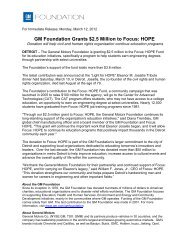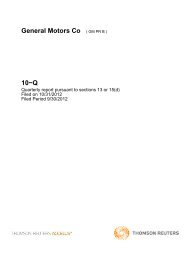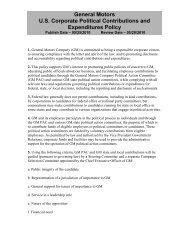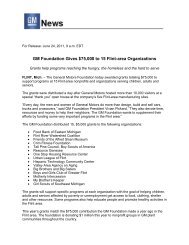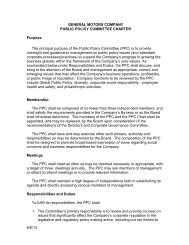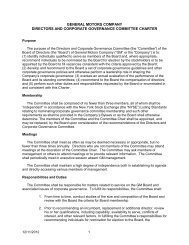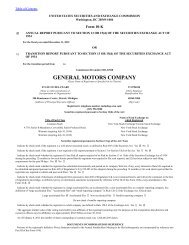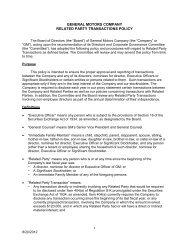General Motors Company
General Motors Company
General Motors Company
Create successful ePaper yourself
Turn your PDF publications into a flip-book with our unique Google optimized e-Paper software.
(a)<br />
Note: Actual compensation amounts paid or earned by the NEOs during fiscal year 2010 are reflected in the<br />
totals that are included in the “2010 Summary Compensation Table” on page 36.<br />
Base Salaries, Salary Stock Units, and Restricted Stock Units<br />
We relied on our comparator information for similar positions to support our recommendations for setting<br />
the base salary for each NEO. As noted above in our discussion of TARP requirements and Special Master<br />
proscriptions, cash base salaries for NEOs of TARP Exceptional Assistance Recipients are not allowed to exceed<br />
$500,000 per year, except in appropriate cases approved by the Special Master for good cause shown, e.g., the<br />
retention of critical talent and competitive compensation data for individuals in comparable positions.<br />
In addition to base salary, the Special Master prescribed SSUs and RSUs. Compensation structures utilized<br />
by our comparator companies consist of both annual and long-term incentives based on achievement of<br />
significant business measures over varying time horizons. However, recommendations for the amount of SSUs<br />
and RSUs which are a part of each NEO’s structure were based on a combination of the Special Master’s rules<br />
and individual circumstances rather than competitive benchmarking. SSUs are not a competitive form of<br />
compensation and are not included in the structures of any of our competitor companies.<br />
Pursuant to the Special Master’s directives, the SSUs were granted to NEOs in lieu of a portion of their total<br />
annual compensation with settlement thereof tied to commencing repayment of our TARP obligations. SSUs are<br />
determined as a dollar amount through the date the salary is earned, accrued at the same time as the salary would<br />
otherwise be paid, and vest immediately upon accrual, with the number of SSUs (granted on or after<br />
December 31, 2010) based on the average of the high and low trading price of Common Stock on the date of<br />
each quarterly grant.<br />
Our NEOs are not allowed to participate in typical types of incentive plans, and we may grant only a limited<br />
number of RSUs whose design complies with ARRA requirements. RSUs were awarded to NEOs on March 15,<br />
2010 under the <strong>General</strong> <strong>Motors</strong> Long-Term Incentive Plan (the “LTIP”). The awards were granted in recognition<br />
of the achievement of 2009 Operating Cash Flow (“OCF”) performance. As discussed below, the RSUs will vest<br />
on the third anniversary of the grant date provided that the executive remains continuously employed with GM<br />
through that date. RSUs will be settled when they vest except that, until all of our TARP aggregate financial<br />
obligations have been repaid, vested awards will be settled in increments of 25% for each 25% of the TARP<br />
aggregate financial obligations that have been repaid. Each RSU represents one share of Common Stock upon<br />
settlement.<br />
As part of our recovery plan, the 2009 OCF target before Special Items for the last six months of 2009 was<br />
set at a cash flow of ($6.0) billion. The Special Items excluded from cash flow from operations were the impact<br />
of discretionary pension and health care contributions, restructuring payments, and capital spending. This<br />
objective performance criterion was developed and reviewed in consultation with the Special Master. At that<br />
point in our operations, the only financial metrics available were derived from financial statements prepared for<br />
post-bankruptcy operations and prior to the preparation of financial statements on a <strong>General</strong>ly Accepted<br />
Accounting Principles (“GAAP”) fresh-start basis. Notwithstanding that the financial target was expressed in<br />
non-GAAP pre-fresh-start measures, it was clear to us and agreed to by the Special Master that the OCF target<br />
had been exceeded based on year-end OCF results of ($2.5) billion. Although we significantly exceeded our OCF<br />
goal, the grants to certain NEOs made on March 15, 2010, were based on the target level (100%) of performance,<br />
which was also the maximum amount payable.<br />
Mr. Akerson was hired as CEO, replacing Mr. Whitacre, on September 1, 2010. He received no cash salary<br />
or SSU grant for the period prior to September 1, 2010, as he was not an employee of the <strong>Company</strong>. His<br />
compensation prior to September 1, 2010 was paid in the form of a director’s retainer as described in the “2010<br />
Summary Compensation Table” on page 36.<br />
Mr. Whitacre received no cash salary or SSU grant after September 1, 2010, as he was not an employee of<br />
the <strong>Company</strong> during the remainder of 2010. His compensation after September 1, 2010, was paid in the form of a<br />
director’s retainer and Chairman’s fees as described in the “2010 Summary Compensation Table” on page 36.<br />
32



